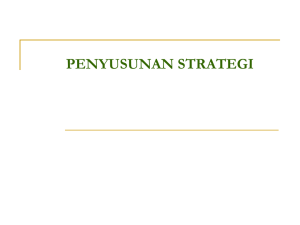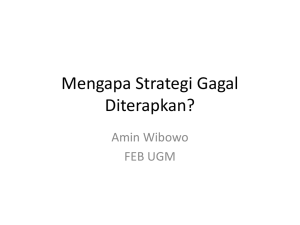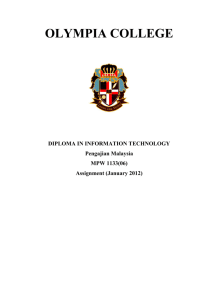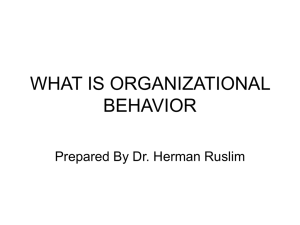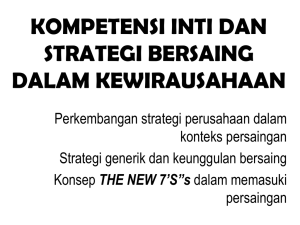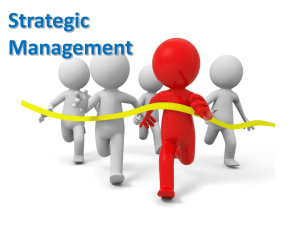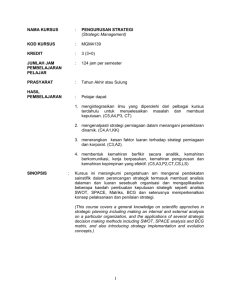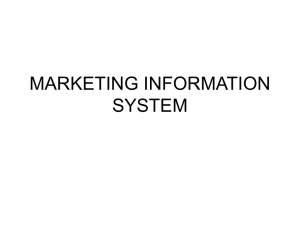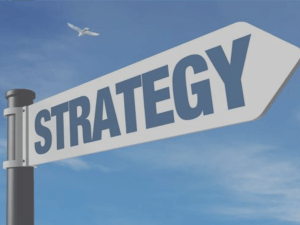Strategi 2: Strategiprosessen
advertisement
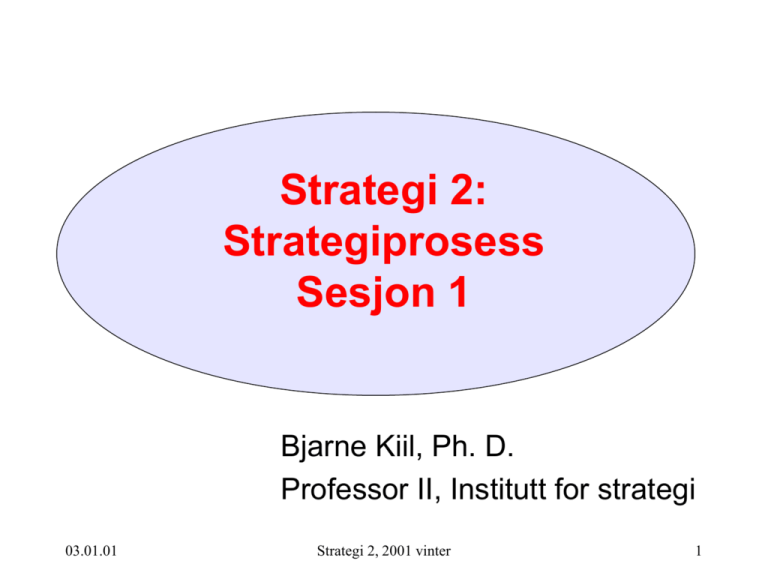
Strategi 2: Strategiprosess Sesjon 1 Bjarne Kiil, Ph. D. Professor II, Institutt for strategi 03.01.01 Strategi 2, 2001 vinter 1 Dimensions of strategy Strategy Process Strategy Content Strategy Context WM 2nd edition, 1.1 03.01.01 Strategi 2, 2001 vinter 2 Levels of strategy Network level Network II Alliance I Corporation Y Business B Corporation T Corporation X Corporation Z Business L Corporation X Corporate Level Business Level Business A Business B Business C Business B HRM Finance R&D Marketing &sales Functional Level Operations Marketing & Sales Product Price Place Promo 03.01.01 Strategi 2, 2001 vinter 3 Towards a theory of Strategic Managament Porter 03.01.01 Strategi 2, 2001 vinter 4 • Process Perspectives – – – – – – – – Programming Incrementalism Logical incrementalism Game theory Strategic intent Strategic core framework Resource base perspective Learning organizations • Innovation – Competing for the future Revolutionary strategies Changing the rule of the game – Competing on the edge – Robust strategies • Views on reality – On predictability – On cognition – On environment 03.01.01 Strategi 2, 2001 vinter 5 Strategic Perspective I Administration 03.01.01 II III Resources Knowledge Imagination Strategi 2, 2001 vinter 6 Andrews strategy model Resource analysis Current strategy Strengths Weaknesses Opportunities Threats Environmental scan 03.01.01 Corporate capabilities Management values Strategic alternatives Strategic decision making Market opportunities Social responsibilities Strategi 2, 2001 vinter New strategy ready to implement 7 The fine art of crafting strategy Though Henry Mintzberg has much to say about how others see strategy, it's less easy to capture what he thinks about it himself Unrealized strategy 03.01.01 Realized strategy Strategi 2, 2001 vinter 8 Strategy approaches • • • The design school: The planning school: The positioning school: • • • • • • • The entrepreneurial school:Strategy formations as a visionary process The cognitive school: Strategy formation as a mental process The learning school: Strategy formations as an emergent process The political school: Strategy formations as a power process The cultural school: Strategy formations as an ideological process The environmental school: Strategy formation as a passive process The configuration school: Strategy formation as an episodic process Strategy formations as a conceptual process Strategy as a formal process Strategy formation as an analytical process Programming * Incrementalism ** * Programming, Prescriptive (how strategy should be made) ** Incrementalism, Descriptive (how strategy gets made) 03.01.01 Strategi 2, 2001 vinter 9 Traditional implicits assumptions • Predictability • Environment is real • Analysis is key 03.01.01 Strategi 2, 2001 vinter 10 The concept of corporate strategy By Kenneth Andrews • "Strategy is the pattern of decisions in a company that determines and reveals its objectives, purposes, or goals, produces the principle policies and plans for achieving those goals" • The strategy process should be a rational and conscious planning activity, in which formulation and implementation are carried out sequentially • The logical activity of planning is preferable to the "muddling through" of incrementalism 03.01.01 Strategi 2, 2001 vinter 11 Definition • "A strategy is the pattern or plan that integrates an organization's major goals, policies and action sequences into a cohesive whole" James Brian Quinn 03.01.01 Strategi 2, 2001 vinter 12 Logical incrementalism (The dynamics of change processes - grounded theory) Seeking: Normative guidance to the strategist • Observation: Such incrementalism is not muddling. It is a purposeful, effective, proactive management technique for improving and integrating both the analytical and behavioural aspects of strategy formulation • Precipitating events - shape future • Analytical - create preparedness, awareness 03.01.01 Strategi 2, 2001 vinter 13 Strategy Process • The manner in which strategies come about. • The how of strategy – How • • • • • • • 03.01.01 is and should strategy be made analysed dreamt up formulated Implemented Changed Controled Strategi 2, 2001 vinter 14 Dimentions of strategy process according to W&M • Strategic thinking Logic – Creativity • Strategy formation Deliberateness – Emergentness • Strategic change Revolution - Evolution 03.01.01 Strategi 2, 2001 vinter 15 Some Key Issues • • • • • • • • • • • Sustainable competitive advantage Attempts to offer prescriptive Strategy Convergence Uniqueness (Target) Literature, S. M. S. (1999 – 2000) Revolutionary Learning Knowledge To be Self Organization process Intellectual capital integrated New Economy Strategic experimentation 03.01.01 Strategi 2, 2001 vinter 16 Breakthrough strategies for seizing control of your industry and creating the markets of tomorrow 03.01.01 Strategi 2, 2001 vinter 17 "Food for thought" • What if predictability is an illusion? • and, what if environment is not real? 03.01.01 Strategi 2, 2001 vinter 18 • Is predictability desireable? • Non-predictability – A problem? – or an asset? 03.01.01 Strategi 2, 2001 vinter 19 Development in strategic thinking FOCUS: Planning Predictability High FOCUS: Process Resources "Confidence in predictability" ? Low 1960 Programming 1980 1990 Resource based Learning Mintzberg Porter 03.01.01 Strategi 2, 2001 vinter Chaos Innovation 20 Strategy, "new" field • Strategic alliances • Networks • Boarderless 1950 1980 Today International • MNC • National responsive • Global 03.01.01 Strategi 2, 2001 vinter 21 • Not one right process • Not one right content • Not one objective context • Not search for the right • Search for a suitable and most likely unique process • Comment to PROJECT 03.01.01 Strategi 2, 2001 vinter 22 Corollary from my experience • Learning within the unknowable • Only possible to get the grips with things that are local to us in space and time • Event driven • Complexity theory 03.01.01 Strategi 2, 2001 vinter 23 Strategic intent Focus Strategic intent Time horizon Effective operation 03.01.01 Strategi 2, 2001 vinter 24 Discovery driven planning Discovery-driven planning recognizes that planning for a new venture involves envisioning the unknown • High ratio of assumptions to knowledge • Systematically converts assumptions into knowledge as venture unfolds • Requires discipline - no less than planning 03.01.01 Strategi 2, 2001 vinter 25 Comments on hazards • Lack of hard data - few key decisions - proceed as assumptions were facts • Hard data available - checking assumptions - but fail to see implications • Hard data available - continual opportunity exists inappropriate assumptions about implementations • Start off with right data - assumes static environment - key variables change unnoticed 03.01.01 Strategi 2, 2001 vinter 26 The ten strategy tensions Chapter Strategy tension Strategy perspectives 1. Strategic thinking Logic vs. creativity Rational thinking vs. generative thinking 2. Strategy formation Deliberateness vs. emergentness Planning vs. incrementalism 3. Strategic change Revolution vs. evolution Discontinuous change vs. continuos change 4. Business level strategy Markets vs. recourses Outside-in vs. inside-out 5. Corporate level strategy Responsiveness vs. synergy Portfolio vs. core competence 6. Network level strategy Competition vs. cooperation Discrete organization vs. embedded organization 7. The Industry context Compliance vs. choice Industry evolution vs. industry creation 8. The organizational context Control vs. chaos Organizational leadership vs. organizational dynamics 9. The international context Globalization vs. localization Global convergence vs. international diversity 10. Profitability vs. responsibility Shareholder value vs. stakeholder value Organizational purpose WM 2nd edition 1.1 03.01.01 Strategi 2, 2001 vinter 27 Perspectives on the TENSIONS • • • • As puzzle As dilemma As trade off As paradox • Or source of reflection and inspiration for own process: – – – 03.01.01 – Design Choice Growth Evolution Strategi 2, 2001 vinter 28 The rational thinking versus generative thinking perspective Rational Thinking Perspective Generative Thinking Perspective Emphasis on Logic over creativity Creativity over logic Cognitive style Analytical Intuitive Reasoning follows Formal, fixed rules Informal, variable rules Nature of reasoning Computational Imaginative Direction of reasoning Vertical Lateral Value placed on Consistency and rigor Unorthodoxy and vision Reasoning hindered by Incomplete information Adherence to current ideas Assumption about reality Objective, (partially) knowable Subjective, (partially) createable Decisions based on Calculation Judgement Metaphor Strategy as science Strategy as art 03.01.01 Strategi 2, 2001 vinter 29 Planning versus incrementalism perspective Planning perspective Incrementalism perspective Emphasis on Deliberateness over emergentness Emergentness over deliberateness Nature of strategy Intentionally designed Gradually shaped Nature of strategy formation Figuring out Finding out Formation process Formally structured and comprehensive Unstructured and fragmented Formation process steps First think, then act Thinking and acting intertwined Focus on strategy as a Pattern of decisions (plan) Pattern of actions (behaviour) Decision-making Hierarchical Political Decision-making focus Optimal resource allocation & coordination Experimentation and parallel initiatives View of future developments Forecast and anticipate Partially unknown and unpredictable Posture towards the future Make commitments, prepare for the future Postpone commitments, remain flexible Implementation focused on Programming (organizational efficiency) Learning (organizational development) Strategic change Implemented top-down Required broad cultural and cognitive shifts 03.01.01 Strategi 2, 2001 vinter 30 Discontinuous change versus continuous change perspective Discontinuous Change Perspective Continuous Change Perspective Emphasis on Revolution over evolution Evolution over revolution Strategic change as Disruptive innovation/ turnaround Uninterrupted improvement Strategic change process Creative destruction Organic adaptation Magnitude of change Radical, comprehensive and dramatic Moderate, piecemeal and undramatic Pace of change Abrupt, unsteady and intermittent Gradual, steady and constant Fundamental change requires Sudden break with status quo Permanent learning and flexibility Reaction to environmental jolts Shock therapy Continuous adjustment View of organizational crises Under pressure things become fluid In the cold everything freezes Long-term change dynamics Stable and unstable states alternate Persistent transient state Long-term change pattern Punctuated equilibrium Gradual development WM 2nd edition, 4.1 03.01.01 Strategi 2, 2001 vinter 31 Chapter 5: Introduction W&M Outside-in perspective Inside-out perspective Emphasis on Markets over recourses Resources over markets Orientation Market / industry-driven Resource-driven Starting point Market / industry structure Firm’s resource infrastructure Fit through Adaptation to environment Adaptation of environment Strategic focus Attaining advantageous position Attaining distinctive resources Strategic moves Market / Industry positioning Developing resource base Tactical moves Attaining necessary resources Industry entry and positioning Competitive weapons Bargaining power and mobility barriers Superior resources and imitation barriers 03.01.01 Strategi 2, 2001 vinter 32 Portfolio versus core competence perspective Portfolio Perspective Core Competence Perspective Emphasis on Responsiveness over synergy Synergy over responsiveness View of competition Firms compete within a business Corporations compete across businesses Competitive strategy at Business level Corporate level Key success factor Responsiveness to business demands Competence leveraging Corporate composition Potentially unrelated (diverse) Shared competence-base (focused) Multibusiness synergy Cash flow optimization Rapid competence building Primary task corporate center Capital allocation to SBU's Competence development and application Position of business units Highly autonomous (independent) Highly integrated (interdependent) Coordination between SBU's Low, incidental High, structural Corporate control style Setting financial objectives Joint strategy development Diversification acquisitions Simple to accommodate Difficult to integrate 03.01.01 WM 2nd edition, 6.1 Strategi 2, 2001 vinter 33 The paradox of competition and cooperation Discrete organization perspective Embedded organization perspective Emphasis on Competition over cooperation Cooperation over competition Structure of the environment Discrete organizations (atomistic) Embedded organizations (networked) Firm boundaries Distinct Fuzzy Preferred position Independence Interdependence Interaction outcomes Mainly zero-sum (win/lose) Often positive-sum (win/win) Source of advantage Bargaining power Specialization and coordination Multicompany level strategy No Yes Use of collaboration Temporary arrangement (tactical) Durable partnership (strategic) Basis of collaboration Power and calculation Trust and reciprocity Structure of collaboration Limited, well-defined, contract-based Broad, open, relationshipbased 03.01.01 Strategi 2, 2001 vinter 34 Industry evolution versus industry creation perspective Industry Evolution Perspective Industry Creation Perspective Emphasis on Compliance over choice Choice over compliance Industry changes Uncontrollable evolutionary processes Controllable creation processes Change dynamics Environment selects fit firms Firm creates fitting environment Firm success due to Fitness to industry demands Manipulation of industry demands Industry malleability Low, low High, fast Normative implication Play by the rules (adapt) Change the rules (innovate) Firm profitability Industry-dependent Firm-dependent Point of View Deterministic Voluntaristic 03.01.01 WM 2nd edition, 8.1 Strategi 2, 2001 vinter 35 Organizational leadership versus organizational dynamics perspective Organizational Organizational Leadership Perspective Dynamics Perspective Emphasis on Control over chaos Chaos over control Organizational changes Controllable creation processes Uncontrollable evolutionary processes Change process Leader commands behavior Behavior emerges from history Change determinants Leader's vision and skill Political, cultural and learning dynamics Form of change Top-down, mechanistic Interactive fermentation Organizational malleability High, fast Low, slow Direction of adaptation Organization follows strategy Strategy follows organization Normative implication Strategize, then organize Strategizing and organizing intertwined Point of view Voluntaristic Deterministic 03.01.01 WM 2nd edition 9.1 Strategi 2, 2001 vinter 36 Dato Tema 3/1 Overganger fra strategi som analyse til forståelse av strategi som prosess. (Bjarne Kiil) 10/1 Utdyping av ulike perspektiver på strategiske prosesser. (Bjarne Kiil) 17/1 Strategiprosess og innovasjon (Øystein D. Fjeldstad) 31/1 Organisasjonslæring med fokus på ledelse av innovasjonsprosesser. (Ragnhild Kvålshaugen) 7/2 Strategiprosessen – konsulent eller lederdrevet? (Reiar Ness) 14/2 Systemdynamisk perspektiv, kaosteori. (Bjarne Kiil/Gisle Henden) 21/2 Endringsledelse – implementering av strategi. (Øyvind Revang) 28/2 Valgt emne og oppsummering. (Bjarne Kiil/gjesteforeleser) 7/3 Strategic leadership and organizational vision. (Mark Kriger) 03.01.01 Strategi 2, 2001 vinter 37 Målsetning, Strategi 2 • Strategiske prosesser i en dynamisk verden, basert på perspektiv-messig mangfold 03.01.01 Strategi 2, 2001 vinter 38 Kursmateriale • Barney, Jay B.: Gaining and sustaining competitive advantage. Addison • Artikkelsamling: Strategiske prosesser. Redaktør Bjarne Kiil. • Anbefalt litteratur – Senge, P. M.: The Fifth Discipline. New York: Doubleday 1990. – De Witt & Myer, Strategy process, content, context. International Thompson Business Press, 1998, 2nd edition. 03.01.01 Strategi 2, 2001 vinter 39 "Punctuated equilibrium" Schrumpetarian development Change Punctuation points Stability Time 03.01.01 Strategi 2, 2001 vinter 40 On Implementation 03.01.01 Strategi 2, 2001 vinter 41 Prosjektoppgave • Case – Finn en artikkel i avis/magasin datert 2000/2001 om en norsk bedrift. For å gjøre denne oppgaven gjør bruk av denne artikkelen, andre artikler, årsrapporter, hjemmesider, o.l. Dere kan bruke caset fra strategi 1, hvis dere vil. 1. Forsøk å klarlegg hvilket strategiprosess-perspektiv bedriften er preget av? – Eksempelvis; planlegging, incrementalism, strategic intent, innovation, eller kombinasjoner av disse. (50%) 2. I hvilken grad er bedriften innovativ? – 03.01.01 Diskutér og begrunn svaret. Kom med synspunkter og forslag til innovative tiltak. (50%) Strategi 2, 2001 vinter 42 Imagination is more important than knowledge (Albert Einstein 1879-1955; German-American physicist) 03.01.01 Strategi 2, 2001 vinter 43 Plans are nothing. Planning is everything (Dwigth D. Eisenhower 1890-1969; American General and president) It is a mistake to look to far ahead. Only one link of the chain of destiny can be handled at a time (Winston Churchill 1874-1965; British prime minister and writer) Alexander the Great 03.01.01 Strategi 2, 2001 vinter 44
